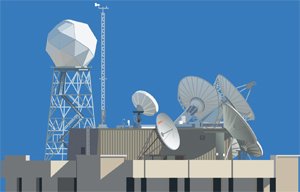 |
Director's NoteWayne Feltz |
In this column (my first) I would like to describe the CIMSS NOAA Cooperative Agreement (CA), its function, current budget status, and new research opportunities for the near future.
One of my new roles as Associate Director CIMSS is to ensure the scientific content and successful operation of our NOAA cooperative agreement mechanism. The agreement acts as a direct funding conduit from NOAA allowing up to 60 million research dollars to flow over a 5-year period. Every ten years all NOAA cooperative institutes are re-competed through a proposal process, which if successful, allows the cooperative institute to continue to exist at a University. A five-year review is conducted in the middle of this ten-year period. CIMSS was renewed as an institute at the University of Wisconsin in 2010, and its 5-year review will be held in early October 2013 to allow the review committee time for consideration and feedback.
CIMSS CA proposals are submitted on an annual basis (five 1-year funding periods). Our current annual CA cycle for proposal submission will end on 30 June 2013 and will not resume until 1 October 2013. How does the CA budget last year compare to this year? The latest estimate when comparing total funding from last year is a 10% decrease due to a variety of reasons, including continuing resolutions, sequestration, and/or science program scale down. While not an optimal situation this year some perspective is in order:
- CIMSS CA total budget has grown every year for more than 10 years
- New CIMSS CA proposals are still expected this month (May)
- CIMSS CA total budget is about 1/3 of SSEC total budget
There are several new opportunities in the near future that will allow CIMSS and SSEC a path forward in these challenging budgetary times. Over twenty 2013 NASA ROSES proposals have been submitted by SSEC/CIMSS principal investigators so far this year, spanning research topic areas from drought impacts, data assimilation, climate studies, cloud properties, atmospheric motion vectors, and mobile device solutions.
The NASA Earth Venture program has engaged SSEC regarding a proposal for engineering the Absolute Radiometric Interferometer (ARI) and for integration into the International Space Station. NASA is particularly interested in obtaining the absolute accuracy possible with the new SSEC black body design.
The NOAA-funded S4 super computer for numerical modeling and data assimilation will likely be expanded in our Data Center to allow integration of operational higher resolution numerical weather prediction models. There is a possibility of SSEC/CIMSS involvement of deploying and operating several ground-based Direct Broadcast polar satellite reception antennas to reduce time latency of derived decision support products through direct overpass acquisition. Thus, while one of our large programs, GOES-R, is going through an expected funding reduction, new opportunities are arising.

